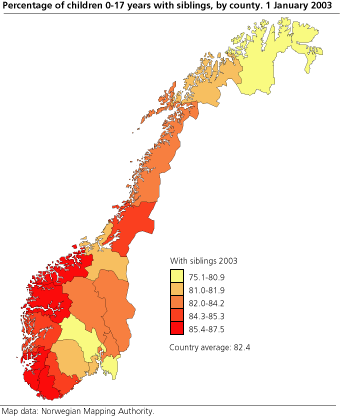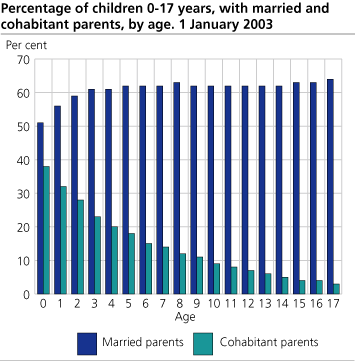Content
Published:
This is an archived release.
5 in 6 children have siblings
The portion of children living with siblings has remained relatively constant over the past couple of years. On average almost five in six children live together with siblings -- most of them in the western and the southern parts of the country.
About 1 066 000 children under 18 years were living in Norway on January 1s t2003. 82 per cent of these had siblings. In this context every sibling who lives at home counts as a sibling, also those who are older than 18 years. There are few deviations from the country average. The portion is highest in the coast counties from Agder to Møre Romsdal and in Nord-Trøndelag. With almost seven in eight children with siblings, Sogn og Fjordane had the highest portion of siblings. In the capital, only three in four live together with siblings. Over the last six years there have not been any significant changes. The portion of children, who lived together with siblings, rose the most in Finnmark - by 2 per centage points.
The majority has one sibling
Most children have one sibling. 464 100 children in Norway, or 44 per cent live together with one brother or sister. Approximately one-fourth lives together with two siblings (304 500 children). Every tenth child under 18 years has three or more siblings.
Eight to ten year olds are most likely to have siblings
40 per cent of all children who did not live together with siblings were newborns. From the age of three this was valid only for every fifth child. The number of children "without siblings" decreases until the age of nine. At this age only 11 per cent of the children did not live with siblings. For the older children we see an increase of "only children". One explanation is that many of the youngest "only children" are first-borns, while some of the older "only children" may have siblings who already have moved from their parent's home.
Six in seven live with biological siblings
On January 1s t85 per cent of all children who grew up with siblings had only biological siblings. In 1997, which was the first year SSB published these figures, the percentage was 88. Children who lived together with only half-siblings amounted to 8 per cent, compared with 7 per cent in 1997. The percentage that lived together with both biological and half-siblings rose from 5 per cent in 1997 to 6 per cent in 2003.
Still three in four children live together with both parents
61 per cent of all children had married parents. Nevertheless, since the first time Children Statistics was published in 1989, the number of children with married parents has decreased from 78 per cent. At the same time cohabitation has become more usual and the percentage of children who live with cohabitant parents has increased from 5 to 14 per cent. This indicates, however, that the increase in cohabitation only partly compensates for the reduction in marriages. Still, three in four children in Norway live with both parents. At the same time the percentage of children that does not live with both parents has increased from 18 to 25 per cent in the last 14 years. The fact that we register an increasing number of children who do not live together with both parents does not necessarily mean that these children do not live together with two adults. It is likely to assume that some single parents have found a new cohabitant.
The largest portion of children with married parents lives in Rogaland and Agder. More than two-thirds of the children in these counties have married parents. The lowest portion of children with married parents was found in Finmark and Troms. Less than half of the children in these counties had married parents.
Cohabitant parents were most common in Nord-Trøndelag and Nordland. About 20 per cent of all children in these counties had cohabitant parents -- compared with an average of 14 per cent for the whole country.
Of all children below one year of age, 28 200 had married and 21 000 cohabitant parents. In other words: 51 per cent of all children in this age had married parents, while 38 per cent had cohabitant parents. The older the children - the more likely they are to live with married parents. 64 per cent of all 17 -year olds, had married parents, only 3 per cent had cohabitant parents. Many cohabitants get married if they do not separate. Since cohabitation is a relative new way of living together, there are very few cohabitants with older children.
More children live with only their mother
181 800 children or 17 per cent of all children live together with only their mother. These children make up the second biggest group. Children living with cohabitant parents only represent 14 per cent.
Tables:
- Table 1 Children 0-17 years , by type of family and siblings regardless of age. 1 January 2003
- Table 2 Children 0-17 years , by county, type of family and siblings regardless of age. 1 January 2003
- Table 3 Children 0-17 years, by relationship. Siblings regardless of age. 1 January 2003
- Table 4 Children 0-17 years, by county and relationship. Siblings regardless of age. 1 January 2003
- Table 5 Children 0-17 years, by number of siblings regardless of age. 1 January 2003
- Table 6 Children 0-17 years of age, by county and number of siblings regardless of age. 1 January 2003. Number and per cent
The statistics is published with Families and households.
Contact
-
Statistics Norway's Information Centre
E-mail: informasjon@ssb.no
tel.: (+47) 21 09 46 42


